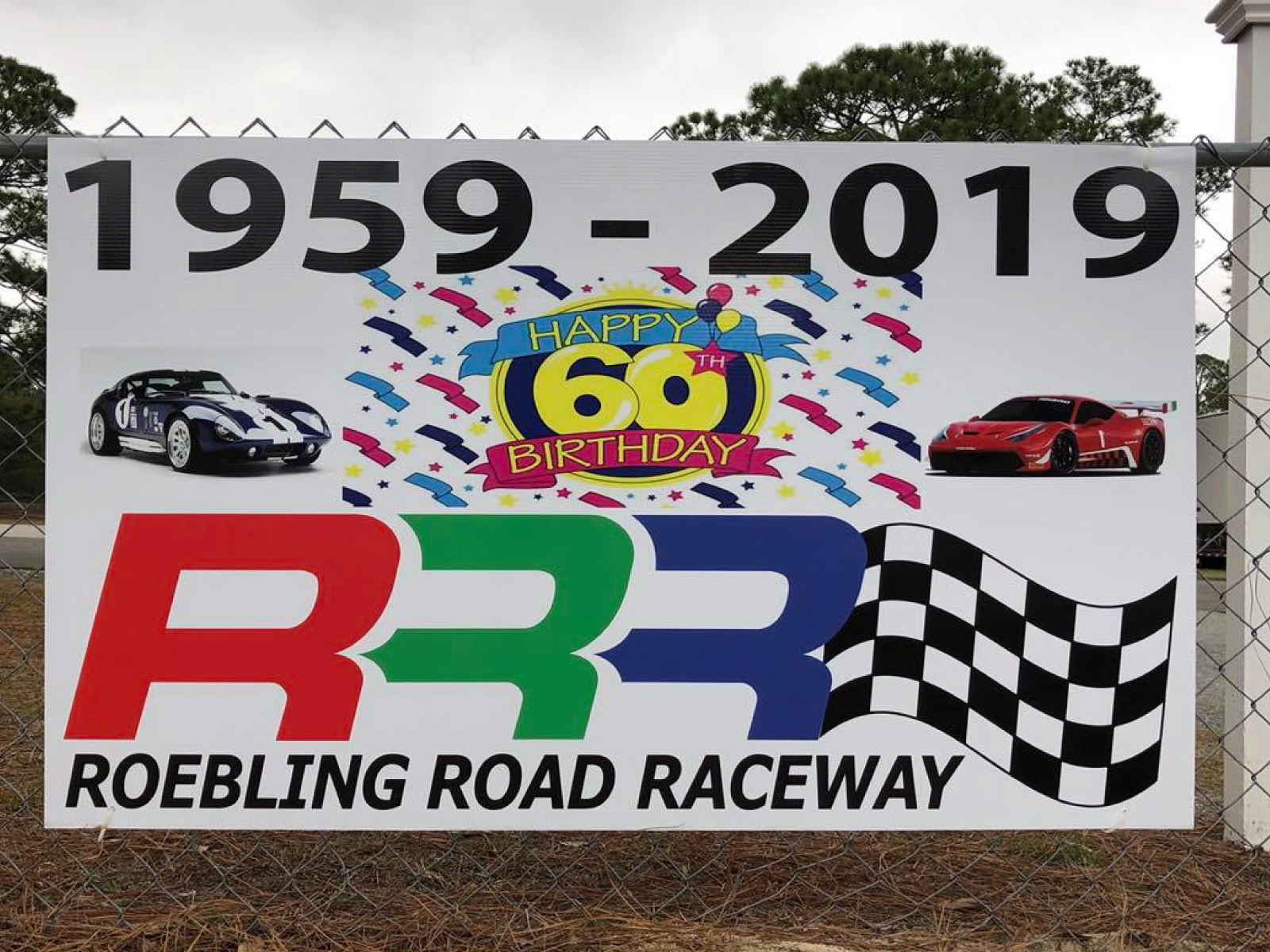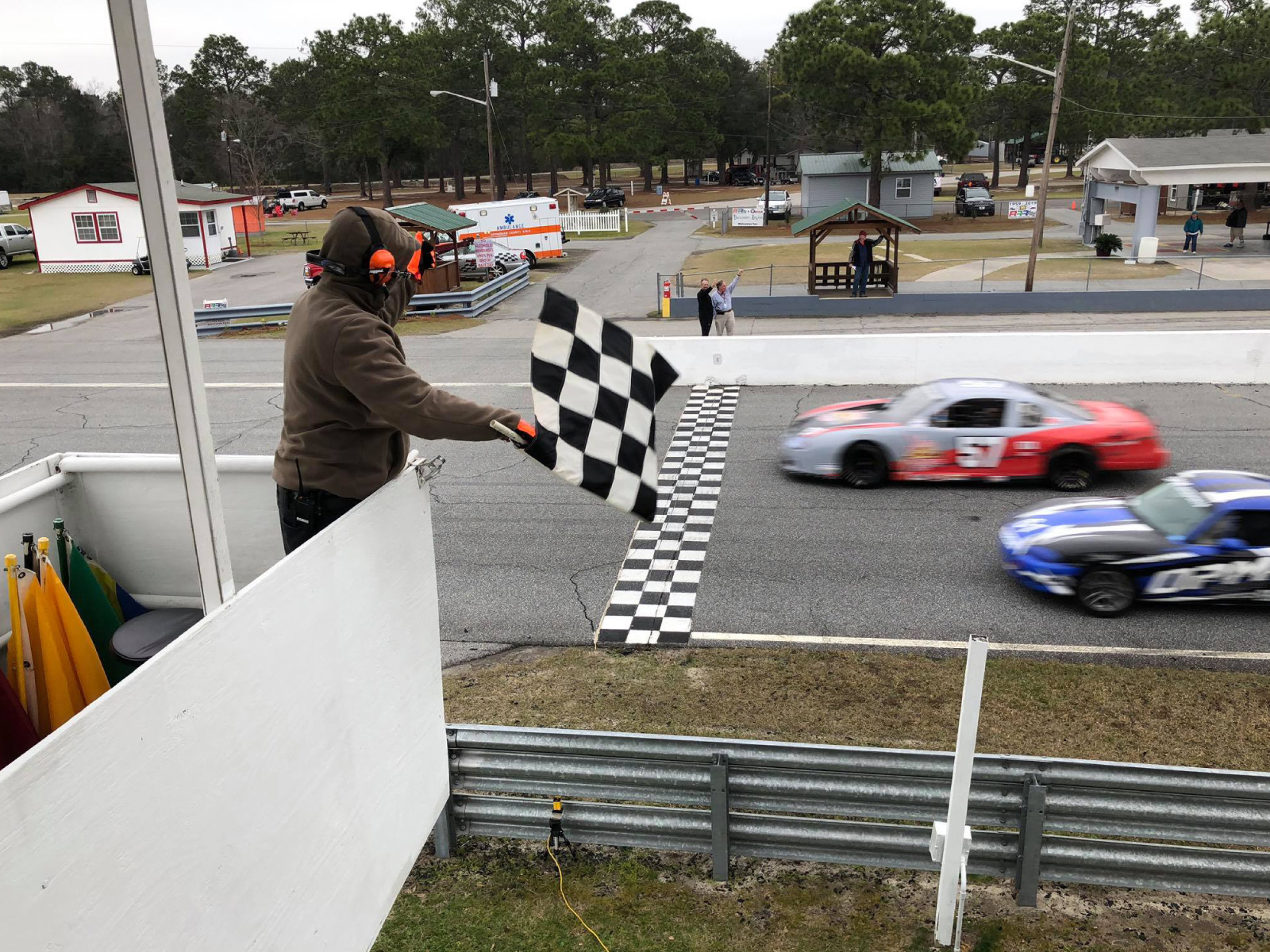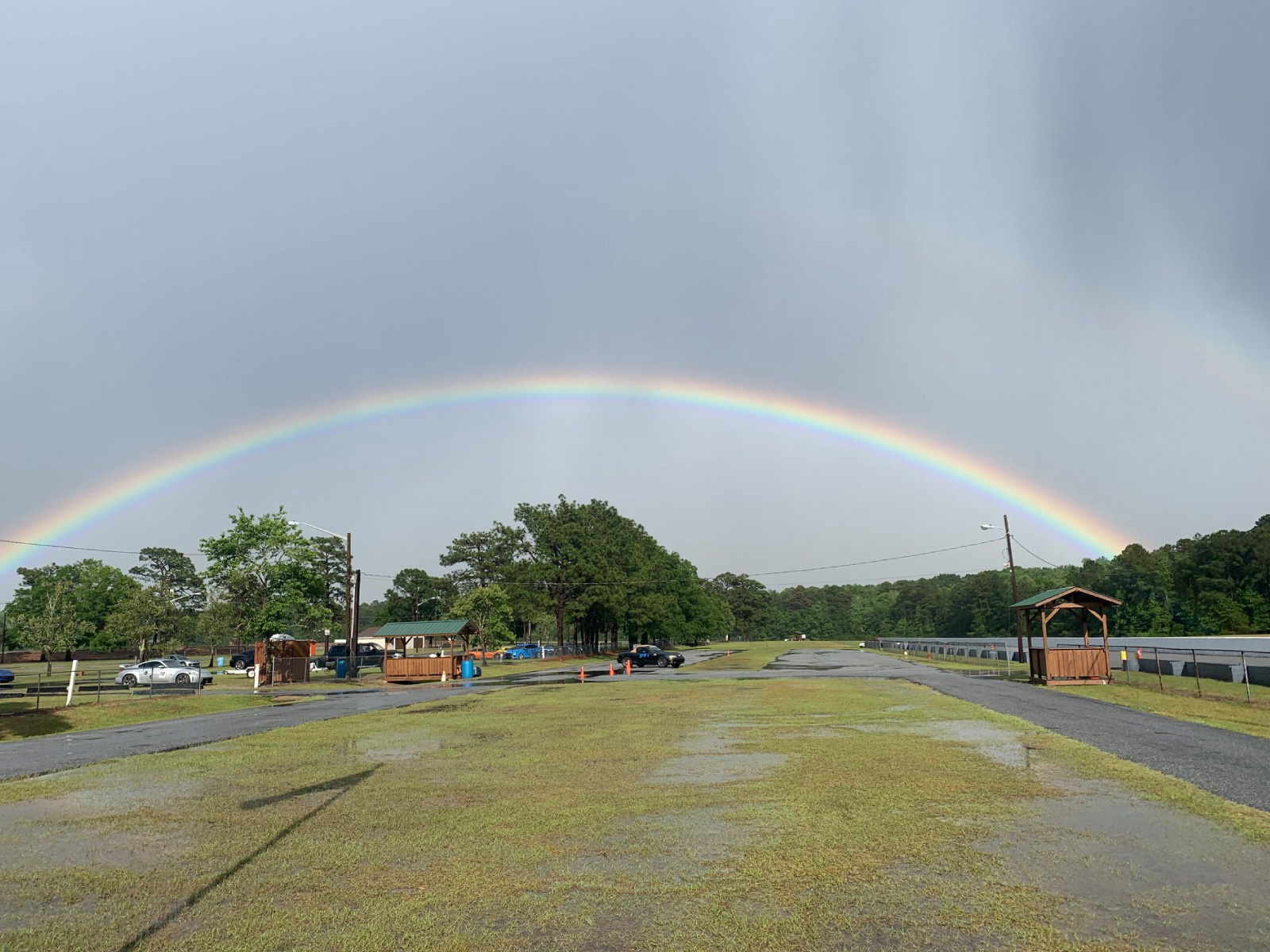


Roebling Road is a track that got started under another name, didn’t do too well, almost died, and then somehow was reborn to become one of the great Club Racing tracks in the country. It would take volumes to relate the countless efforts of hundred of volunteers that made this come about.



The beginning of sports car racing in the Savannah area goes back to 1910 when the first Vanderbilt Cup Race was held on the streets of Savannah. There was occasional racing in the Southeast over the years, but as time went on and the Sports Car Club of America was developed and worked its way south, races were held at Hunter Air Force Base—part of the Savannah area—and other airport tracks. Among the regular participants were Robert Roebling and John Reuter.
Mr. Roebling was a very important citizen of Savannah and scion of the Roebling Wire Rope family, which built the
Brooklyn Bridge. As a racing enthusiast, he attended many races and had sports cars of that day. He had the financial resources to back up his desire to race, and he was also very interested in promoting sports car racing.
His close friend, John Reuter, was very well-known in sports car racing around Atlanta and in the SCCA. He was a driving force in sports car racing for many, many years. The Southeast Division established the John C. Reuter Award in his name, which was awarded to Buccaneer Region member Tom Nehl in 1980.
Mr. Roebling and Mr. Reuter got together and said, “Let’s build a race track.” That sounds a little like Mickey Rooney and Judy Garland saying, “Let’s put on a show!”
They found a piece of property in South Eppingham County, apparently an old farm of about 800 acres with very limited access—just one little muddy trail about 20 or 30 feet wide. Mr. Roebling bought that land, probably for a song. It wasn’t worth a hell of a lot, but on it were some good, high, dry parcels—and that’s where they designed a track.
Mr. Roebling was not only a very important person in the Savannah area, but I think a politically influential person, too. It just so happened that at the time Mr. Reuter and Mr. Roebling wanted to build the race track, the State was building Georgia Highway 17, which went north of U.S. 80 from Faulkville and up into central Georgia just west of the property. As state officials were building the highway, they needed a place to store their road grading equipment and dump trucks.
Mr. Roebling very graciously allowed the Georgia Highway Department to store all its road building equipment on his newly acquired land—and as the road building equipment went in and out of his property, they were able to scrape a little here and there, move a little dirt here and there. They “practiced” on Mr. Roebling’s land so they could do a perfect job on Georgia Highway 17.
But the result of all that practice was that the base of this 2.05-
mile track was constructed. As a matter of fact, it was built to the exact same specifications as Georgia Highway 17, even to the point of putting drainage culverts in certain areas of the track. You can see one under Turn One and one under Turn Seven. Mr. Roebling paid for the paving, but I don’t think he paid for anything else.
A Grand Opening Day and race were staged in August 1958. It was well-covered by the press and attended by racing VIP’s of the time. The new track was christened “Savannah International Raceway.” Mr. Roebling and Mr. Reuter worked with the local SCCA Region, then called the Savannah Region, and put on a few racing events.
In 1958, Mr. Roebling organized a corporation called the Council for Traffic Safety, and named Marvin Davis as president. He then donated the track to this group and got a large tax credit.
Mr. Davis, coincidentally, was Executive Director of the Savannah Foundation, which was the equivalent of the United Way in Savannah at that time. John Reuter was Manager and First Instructor for this facility.
The Council for Traffic Safety operated in 1959 and 1960 and persuaded Georgia Teachers College and the state police, the local high school, and local police to utilize the facility to train drivers. In fact, George Teachers College had a course at the time to train students in driving. I don’t think they called it racecar driving, but maybe defensive driving.
But Mr. Reuter died, and Mr. Roebling’s enthusiasm for racing— and the track—diminished. And after that, the Council for Traffic Safety never did very well.
The Savannah Region was never very strong with only about eight members, and was essentially an inactive sports car club. But the track was in its assigned SCCA territory, so they ran a race every year or so with help from other Regions. The track had that same pavement as was on Georgia Highway 17, and was hard on tires, and car owners complained. As a result, it was hard to get enough entries. Car counts were as low as 50 to 60 for a weekend of seven races and twenty classes of cars. By 1971, the Savannah International Raceway was getting very little use.
The Gator Region of Northeast Florida rented the track every year from the mid-1960’s through 1971 to hold National races, which was a big event for the Gator Region. For 1972, the Gator Region asked Tom Nehl, a member since 1967, to be Race Chairman. Organizing a National race is quite an undertaking, and those who have done it know how much work is involved. We were required to furnish insurance to the property owner and arrange to rent the track. The track was by then owned by the Savannah Foundation.
In the process of delivering the race insurance to Mr. Marvin Davis, President of the Savannah Foundation as well as the President of the Council for Traffic Safety, Mr. Nehl got acquainted with Mr. Davis, who was impressed with the business-like way everything was handled. After we ran the race in 1971, Mr. Davis contacted Mr. Nehl and asked if he would like to take over the track, rent it, and operate it.
After a few seconds of thought, Mr. Nehl said “I don’t think I want to do that. But I might buy it from you.” Mr. Davis said “Make us a proposition.” After studying all aspects, Mr. Nehl put together an offer designed to be attractive consisting of cash plus contributions for the next five years to complete full payment, plus a promise to unite the Savannah and Gator Regions to manage the track and a pledge to keep it operating for at least five years.
A meeting was held in Brunswick, and the two Regions decided how to merge. It was decided on the name Buccaneer Region, which is really the proper name because pirates raided on the Florida and Georgia coasts in the 1700’s and 1800’s. Thus, the Buccaneer Region came into existence in 1972.
The Buccaneer Region came into existence in 1972 as a result of the merge between the Savannah Region and the Gator Region. Following the merge, the track (Savannah International Raceway) was rented to the Buccaneer Region for $1 per year by Mr. Nehl. The lease included three stipulations: pay the $1 per year; run at least three (3) SCCA-sanctioned events every year; and keep the insurance up to date.
All three of the covenants were carried out and the checks were never cashed. They are in one of Mr. Nehl’s files somewhere.
The Buccaneer Region ran a Driver’s School, a Regional Race, and a National Race each year, with success, but attracted few entries because of the problem with the abrasive track surface. Still, many improvements were made.
First, a concession stand and restrooms were constructed. Work parties moved some guardrails and added more with donated material. Communication lines were buried to every racing corner so activities could be reported between officials and corner workers. Mr. Nehl donated a used truck body for equipment storage and a used flatbed truck for various chores. A 1500-foot deep water well and water pumping system were put in. An old road grader was bought, fixed-up, and added to the Nehl farm equipment and frequently used by Buccaneer Region to improve the access road, make a new entry road from an adjoining public road, and other work as needed.
A Tech Shed was constructed using material donated and hauled to the track by Tom Nehl Truck Company, who also salvaged an old diesel truck and had a dump body installed. It was used for years by the track and the farm for many chores.
Next, Mr. Nehl traded a used pickup for material from a demolished bank drive-thru. The trade included the material loaded on a borrowed flatbed trailer. Using a truck-tractor borrowed from the truck company, all of the material was hauled up to the track and stored in the barn that came with the land.
He then designed a three-story Timing and Scoring building and made a model of it scaled to the dimensions of the material from the bank. A local builder was hired to put the jigsaw together. He did a great job and used most of the material, including the stairs, the air conditioner, the colored glass windows, and panels.
Mr. Nehl either donated material or financed part of the cost and worked many weekends with Region members and friends to complete the various projects. The Buccaneer Region always paid the loans as agreed.
It was in 1976 when the idea was developed to rename the track in honor of Mr. Roebling. At the time, Mr. Nehl still owed the Savannah Foundation $4,500 on his payment pledge, so he told them “If you will forgive that $4,500, we will rename the track and build an entrance wall with a plaque on it, calling it ‘Roebling Road’.” They were happy to honor Mr. Roebling, and gave the go-ahead. The Buccaneer Board approved.
Mr. Nehl had a lot of fun designing the plaque on a drawing board in his office, and came up with a full-scale drawing for the plaque. The design is still in use for patches, stationery, etc. A Jacksonville brass foundry made a mold and cast the plaque in bronze. It was taken to the track and installed in the newly built wall.
The Track and the Region invited Mr. and Mrs. Roebling to “Roebling Day”, a celebration to unveil the plaque and introduce the new name. The design drawing was mounted and frames, and all the racers and workers who were present signed it, and presented it to Mr. Roebling. The presentation of the drawing and the unveiling of the plaque were followed by a banquet under the trees. In subsequent correspondence, Mr. Roebling was lavish in his praise of a very memorable day and the “Ducal” hospitality he enjoyed. He said he and Mrs. Roebling were made to feel at home from the very moment they arrived at the gate.
By then, the Track was up and running well, but still suffered from the coarse pavement. It was soon realized that the track would have to be paved with a new tire-friendly surface if increased entries was to be attained.
The best racetrack paving known at that time was at Road Atlanta, where many of the Region members had raced their cars—and it was always a good racing surface.
The Finley Company in Statesboro, GA was contacted and asked to communicate with Road Atlanta and find out who had paved it, and what the formula was (the mixture of sand, gravel, etc.). The Finley people were able to come up with the formula and get the materials. However, they had to use a substitute for the sand because it was different in South Georgia than North Georgia.
The estimate for a complete repaving was $63,000. Where would that money come from?
The Regional Executive at that time was Andy Johnston. He and his wife, Jackie, were very active in the Buccaneer Region, and the two of them were a good team. They worked hard and did a lot of good things for the Region. Here in Jackie’s own words is how the money was raised:
“The Region didn’t have the funds it would take. The Board got together to try to figure it out and the consensus was that Tom Nehl could afford to pay for it. A few of us were “volunteered” to approach the intimidating owner, and see if he would pay for the repaving. To this day I remember vividly sitting in Tom’s living room and what his answer was. Quote ‘I could pay for the repaving of the track, but I would rather burn fifty-thousand dollars in my front yard than just give you the money. Show me the Region is behind this by raising half the money, and I will match it.’”
The Buccaneer Region accepted the challenge, and Jackie went after contributions from SCCA members and Mr. Nehl went after racing suppliers and his many racing friends. The Region raised $24,000, which Mr. Nehl matched and then loaned the Region the $15,000 needed to bring the total to $63,000.
In the process, the Roebling Road Runners& Pavers Club was established to honor all contributors of $100 or more with their name on a display board located in the paddock area, and now located in the Tech Shed. If you look at the board the next time you are at the track, you will recognize some pretty good racing names.
At the first race after paving, Mr. Nehl was asked to take the first lap in his Lotus Super-Seven. With the new pavement, lap times were found to be about five seconds faster!
Following that first race on the newly paved track, Roebling Road became extremely popular for not only racing, but for testing and other kinds of racing, such as motorcycles and historic cars. The track is now rented about 300 days a year where racers and their families come to test, race, camp out and enjoy Roebling Road.
Over the years, Regional Executives and Board members have managed the track well and it continues to generate substantial income, which is spent on improvements. Among them: a new Timing and Scoring building at Turn 4 (since then converted to a race officials meeting room); a state-of-the-art computerized scoring system; radio communications from tower to corners; PA system; medical building; track wrecker; new residence for line-on-property track managers; new covered pavilion and benches in front of the concession stand; pipe-in water from a centralized system; electrical outlets for campers; paved infield roads; another track repaving in 1997; and expanded infield with new facilities for camping and viewing. The result of this prosperity and success has seen the Buccaneer Region membership grow from less than 100 when it was born in 1972 to almost 500 today (ed. note: now almost 600).
In 1979, the Buccaneer Region started the Tom Nehl Classic National Race weekend, held in the middle of March each year. It draws ±200 entries each year, as do most of the track’s events.
The Robert Roebling era was from 1955 to 1972. The Tom Nehl era was from 1972 to 1992. The Buccaneer Region era began in 1992 when the racetrack was sold to the Region for about 1/3 of its value. Mr. Nehl took a 15-year mortgage, which was paid in full in less than 10 years.
The Buccaneer Region of the SCCA has become one of the most prosperous Regions in the Country, and the only one to own its racetrack — fully paid for. It has become one of the finest non-spectator facilities in the Country. Buccaneer members, past and present, can be proud of what they have accomplished.